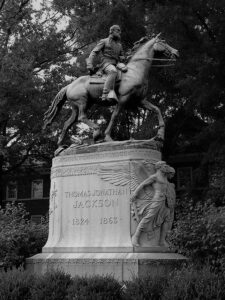
In Charlottesville and Richmond, the fate of historical statuary hangs in the balance.
by Catesby Leigh
Charlottesville’s public spaces suffered major degradation after George Floyd’s killing, thanks to the removal of five noteworthy statuary works erected between 1909 and 1924: a Confederate sentinel known as Johnny Reb perched on an elaborate pedestal flanked by two cannons in front of the Albemarle County Courthouse; equestrian statues of Robert E. Lee and Stonewall Jackson; a Lewis and Clark monument that included the crouching figure of their Shoshone interpreter Sacagawea; and a monument to Revolutionary War hero George Rogers Clark, famous for his exploits in what became the Northwest Territory. This tribute to the “Conqueror of the Northwest” included seven figures in a scenographic tableau, with Clark alone on horseback as his party encountered a group of Indians.
Except for the Johnny Reb, these monuments were the work of noted artists and individually designated on the National Register of Historic Places as well as the Virginia Landmarks Register. All, again excepting the Johnny Reb, were donated by an exceptionally generous philanthropist, investment banker Paul Goodloe McIntire (1860–1952).
And all ran afoul of racial-grievance activists, whether black or Native American, and their indispensable coterie of woke white allies convinced that the monuments’ removal will somehow improve the lives of historically marginalized minorities. It won’t, and the grievance community will just move on to the next hot-button issue. Only the handsomely decorated pink-granite pedestal of the Lewis and Clark, rising from a lushly planted traffic island, remains. Evidently the pedestal is considered politically acceptable in the statuary’s absence, especially that of the unacceptably subordinate figure of Sacagawea.
Charlottesville’s historic fabric boasts a strikingly intimate scale that the statues greatly enriched. The solemn figure of Lee, portrayed returning from his surrender at Appomattox, was situated at the crest of a gentle incline in a downtown square, while Jackson, shown riding at a brisk pace during his Shenandoah Valley campaign, animated a park alongside the fine brick county courthouse. The nearby figure of Johnny Reb, sheltered by a lofty elm, terminated a street axis, while the courthouse with its elegant white trim and Ionic portico provided a classic backdrop. The Clark statuary group anchored another small park on the University of Virginia campus, located a short walk from Thomas Jefferson’s magisterial Rotunda.
The Lee statue, removed from the downtown square in July 2021, has attracted the most attention. Last December, Charlottesville’s city council approved, in a procedurally shady manner, a midnight resolution to hand the bronze over to the city’s Jefferson School African-American Heritage Center so that it could be melted down into ingots and recast as an artwork reflecting contemporary “community” values. Backers of this “Swords Into Plowshares” project include George Soros’s Open Society Foundations and UVA’s Democracy Initiative—the latter supported by the now-woke Andrew W. Mellon Foundation. Documents that the heritage center expeditiously submitted to the city provided a detailed plan to proceed with the cutting up and transport of the statue from the city yard where it was being stored to a Tennessee foundry within two weeks of the council vote. For months, it seemed that the statue had most likely been destroyed.
But the plot has thickened. In April, a Charlottesville circuit court judge, Paul M. Peatross, issued a letter-opinion provisionally ruling that the city council vote violated 2020 state war-monuments legislation that permits local governments to “remove, relocate, contextualize or cover” war monuments—Civil War monuments included—but not to alter or destroy them. Most importantly, the heritage center, which mainly functions as a museum, stated in a June court filing that while it still intends to melt the Lee statue down, it had so far only disassembled it. It is not known whether the delay resulted from the center’s meltdown plan going awry, and in fact it’s not certain what its meltdown plan was. According to the documentation it submitted to the city last December, a team sent by Vinnetti’s Gallery and Foundry, headquartered in Nashville, was supposed to handle the disassembly and transport of the statue to Tennessee for melting down. Co-owners of Vinnetti’s told me earlier this year that they had nothing to do with the operation and first heard of it from news reports.
Alternatively, the delay might reflect the center’s own doubts about the legality of the city council action, which prompted a lawsuit from two Virginia foundations that, like the center, submitted offers for the Lee monument. One, the Trevilian Station Battlefield Foundation, owns 2,500 acres at the site of the Civil War’s largest all-cavalry battle, while the other, the Ratcliffe Foundation, owns a rural house museum associated with a brother of Confederate cavalry commander J. E. B. Stuart. Aside from the state’s monuments legislation, the plaintiffs charged the city with violations of Virginia’s procurement law and Freedom of Information Act, and in his April letter-opinion Peatross overruled the city’s motions to have these charges dismissed. He also dismissed charges against the center, though it remains a party to the suit.
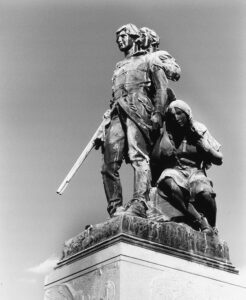
At an October 10 hearing, the judge declined to render summary judgment in the case. A bench trial will take place in February. In the meantime, a protective order Peatross issued late last month authorizes the plaintiffs’ legal team and experts of their choosing to inspect the Lee statue, which was cut up into a half-dozen pieces before its removal from the Charlottesville yard. Inspection is essential to determining whether the statue can be restored to its original state and thus what kind of relief the judge can prescribe—for example, whether he can order the city to issue a new solicitation of offers for the Lee monument, whose disassembled stone pedestal remains in the yard. And that raises another question: Should Peatross order a new solicitation, will he instruct the city to forbid the monument’s future destruction or alteration as a condition of its transfer to new ownership? In any event, the protective order requires the statue’s location to remain secret for the time being.
Should the city lose at trial, it can appeal. The case will likely drag on for some time. And where Confederate monuments are concerned, Virginia’s supreme court showed itself to be closely aligned with the woke with its landmark September 2021 decision permitting former governor Ralph Northam to remove Richmond’s majestic Lee monument, which stood on Monument Avenue—once one of the nation’s finest thoroughfares as well as a National Historic Landmark—for over 130 years.
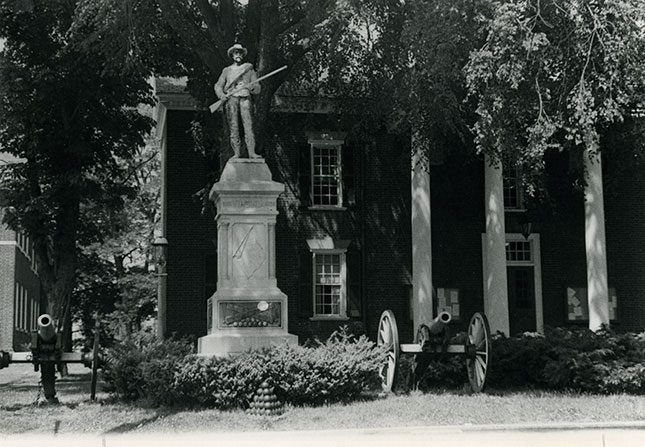
The case of Charlottesville’s Lee matters because woke activists can be relied upon to push the iconoclastic envelope. If the statue is destroyed, a truly toxic precedent will have been set—one especially threatening to the dozen Richmond monuments with Confederate associations removed from Monument Avenue and other sites in 2020 and 2021. In that light, it is worth noting that letters to the Charlottesville city council supporting the Lee meltdown came not only from the interim director of the Black History Museum (BHM) and Culture Center in Richmond but also the director of a major River City museum, the Valentine.
In January, Richmond’s city council donated the banished city-owned monuments to the BHM, an institution with inadequate resources and facilities for their upkeep and display. Also included in the donation, initially trumpeted by Mayor Levar Stoney, was the formerly state-owned Lee equestrian. The shrink-wrapped 12-ton statue and its titanic, 40-foot-tall granite-encased pedestal now languish in a state of dismemberment, along with the other Confederate monuments, on the grounds of Richmond’s wastewater treatment plant. (A Richmond judge’s recent ruling makes it very likely that the last Confederate standing on the streets of Richmond—A.P. Hill, a bold if erratic commander in Lee’s Army of Northern Virginia—will soon be joining his brothers in arms at the plant. This larger-than-life-size statue and its tall pedestal, situated in a traffic roundabout on Richmond’s North Side, have posed a more complicated case because they surmount Hill’s grave.)
A contract between the city and the BHM makes the donation contingent on the BHM coming up with a workable plan for taking possession of the monuments. Under the contract, the Valentine will play an essential supporting role in determining their “future use.” It would not be surprising if philanthropies such as the Mellon Foundation, which in 2020 launched a $250 million initiative for the reconfiguration of the nation’s commemorative landscape along woke lines, get involved. “Everything’s on the table,” Marland Buckner, the BHM interim director, replied last February when asked if the Charlottesville meltdown could serve as a precedent for Richmond. Buckner resigned in June by mutual agreement with the museum, but it would be foolish to discount his menacing remark. A former congressional staffer and Microsoft lobbyist in Washington, Buckner is married to Melody Barnes, onetime director of President Obama’s Domestic Policy Council and now a law professor at UVA and co-director of its Democracy Initiative—a key backer of the Charlottesville meltdown through its so-called Memory Project.
The contract Buckner signed in May with the city of Richmond, on the BHM’s behalf, suggests that where Richmond’s Confederate monuments are concerned, everything really is on the table. The contract—obtained under the Virginia Freedom of Information Act by Charlottesville resident Philip Andrew Hamilton, 35, a libertarian businessman and LSAT tutor—contains no conditions regarding their long-term physical integrity or conservation or any acknowledgement of their artistic significance. The only abiding condition concerning the statues’ future use is a ban on their contributing to “perpetuation of what is commonly referred to as the ‘Lost Cause’ ideology and the commemoration of a pre-Civil War historical perspective that included slavery as an accepted practice.”
So there was no infringement of the contract between the city and the museum when, thanks to a loan from the BHM, the Valentine and its opportunistic director, William J. Martin, opted to exhibit the battered, paint-splattered Jefferson Davis statue from Monument Avenue’s grandiose tribute to the Confederate president lying on its back—with vestiges of a toilet-paper noose, wrapped around the figure’s neck by rioters during the George Floyd mayhem, still in place. The statue, on display in its ravaged state since last June, is the work of Edward Virginius Valentine (1838–1930), a prominent Richmond sculptor and brother of the museum’s founder.
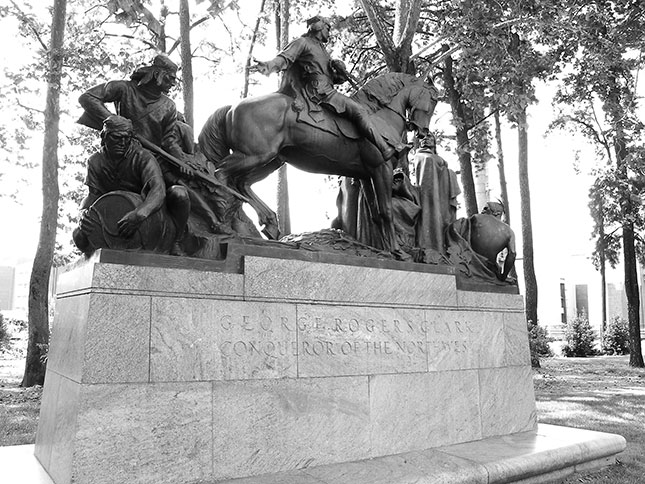
The Robert E. Lee equestrian that once adorned Monument Avenue was deeded to Virginia, along with the spacious, turfed circle it occupied until last year, under a restrictive covenant entailing “the guarantee of the state that it will hold said statue and pedestal and ground perpetually sacred to the monumental purpose to which they have been devoted.” That covenant, authorized by an 1889 joint resolution of the Virginia legislature, did not deprive the state of the right to transfer ownership of the monument and its plot of land to another party. The question is whether former Democratic governor Ralph Northam had the right to abrogate the covenant and order the Lee monument’s removal on the grounds that it amounted to “government speech” that deviated from current “public policy.” In condoning Northam’s action, Virginia’s supreme court may have dealt a significant blow to the sanctity of contracts. In a Hail Mary petition to the U.S. Supreme Court filed on behalf of former Lee monument neighbors, a distinguished attorney, Patrick M. McSweeney, warned that the Virginia court’s capricious decision, if not overruled, would have serious ramifications—not only in Virginia, and not only for Civil War monuments, but also for “conservation and preservation easements; development agreements between governments and private parties that include deed restrictions or other conditions; agreements related to donations to hospitals, universities, and charities; and virtually any state government contract whenever a government official or judge may decide unilaterally [as Northam did] that a state contract offends public policy.” The Roberts court denied the petition without comment in March. John Marshall, the nation’s greatest jurist and one who well understood the vulnerability of contracts to the heated vicissitudes of politics, must be turning over in his Richmond grave.
Before leaving office in January, Northam—unflatteringly nicknamed “Governor Blackface” after his medical school yearbook page, featuring a photo of a young man in blackface and another in hooded KKK attire, turned up in 2019—handed the disassembled Lee monument and its former site to the city of Richmond. Whether he had the legal authority to do so without making it possible for other parties to bid for the monument through a publicly announced process—which he did not do—is unclear. Much more legally problematic is Richmond’s donation of its Confederate monuments to the BHM. The city established a formal process for transferring ownership of its banished landmarks in accordance with the 2020 war monuments legislation and received more than 20 offers for the statues, excluding the Lee. The BHM never submitted a bid for the monuments, so it has no business acquiring them. Sad to say, no one has stepped forward to challenge the actions taken by Northam and the Richmond city council in court.
This is worrisome. As already noted, Virginia’s local governments cannot legally destroy war monuments, and if Peatross’s April ruling stands, they will not be permitted to contract to transfer ownership of such monuments with a view to their destruction, as Charlottesville’s city council did. But so long as monumental transfers to private entities such as the BHM occur with no conservation strings attached, those entities would appear to be free to alter or destroy the monuments they acquire. The director of LAXART, a Los Angeles “visual art space” that last year paid Charlottesville $50,000 for its Stonewall equestrian, recently gushed at the prospect of Chicago-based Bethany Collins—“a multidisciplinary artist whose conceptually driven work is fueled by a critical exploration of how race and language interact,” in her gallery’s words—displaying granite from the monument’s beautifully decorated but grievously vandalized pedestal cut into an array of rose petals such as Charleston freedwomen laid on the graves of Union soldiers in May 1865. The Stonewall pedestal’s front featured winged allegorical figures of Valor and Faith, whose toes and fingers were broken and noses chipped off by leftist agitators—two of whom, both white men, were arrested at the statue site in December 2019, charged with felony vandalism and trespassing, and given slaps on the wrist in the form of suspended 30-day sentences after pleading no contest.
LAXART’s Stonewall purchase resulted from the same solicitation process through which the heritage center acquired the Lee, though without any indication in this case of what might be done with it. The purchase could result in the Stonewall bronze itself being “reconfigured” or “melted down.” Both options, along with maintaining the statue intact, were noted by the LAXART director, Hamza Walker, in an interview with the Charlottesville Daily Progress last July. (He also revealed Collins’s pedestal-into-rose-petals scheme in that interview.) The somehow “transformed” Stonewall monument will be displayed in the fall of 2023 in an exhibit that LAXART and L.A.’s Museum of Contemporary Art are organizing. Some 15 “decommissioned” Confederacy-linked statues from several cities, Richmond of course included, will be juxtaposed to woke works of contemporary art. Not surprisingly, “lead support” for the exhibit is being provided by the Mellon Foundation, according to LAXART’s website. Whatever happens to the Stonewall equestrian—a spokeswoman for LAXART and MOCA had no comment on Walker’s Daily Progress interview, saying “planning for the exhibition is still underway”—his remarks show just how deeply ingrained “anti-racist” lunacy has become within certain sectors of our cultural elite.
White supremacists, such as the Unite the Right crew that converged on Charlottesville in August 2017 to protest the city council’s vote to remove the Lee monument, have scant political traction in today’s Virginia. But you wouldn’t know that given the enormous coverage accorded their clash with a far larger contingent of counter-protesters that left one of the latter dead as a result of vehicular homicide. What the success of wokedom’s anti-monumental jihad in Charlottesville and Richmond has really demonstrated is the Left’s increasing political dominance of Southern cities as well as its ability to make a mockery of the law. It has also demonstrated the near irrelevance in such locales of old-line heritage organizations such as the Sons of Confederate Veterans and the United Daughters of the Confederacy. The Richmond headquarters of the UDC, which once took the leading role in erecting many a monument to the Lost Cause, were torched during the 2020 Black Lives Matter-Antifa riots.
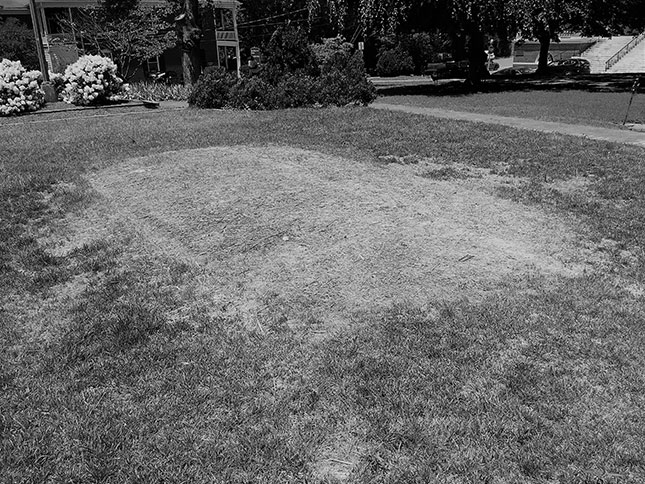
Apossible harbinger of better things to come is Charlottesville’s Monument Fund, which has supported litigation in defense of the city’s Lee and Jackson monuments. The organization’s website makes the historically and culturally informed case that eradicating the city’s monumental legacy has left its public realm flatter and dumber. Instead of slogans, it offers common sense, which has been in short supply in recent years. For most people, appreciation of the artistic value or historical significance of Confederate monuments—caricatured in the woke media as cultic “veneration”—has nothing to do with airbrushing the South’s history.
But Virginia’s Republican governor, Glenn Youngkin, wants to sweep the Confederate monuments issue under the rug. He’s never questioned the removal of the Richmond and Charlottesville monuments, merely insisting that banished statues and pedestals be consigned to museums or battlefields so that “we don’t lose our history.” As far as I know he has said absolutely nothing about the real danger woke fanaticism poses to the physical integrity and even survival of important Confederate monuments. He should have long since adopted a simple, three-word general policy guideline for statuary in the Old Dominion’s public squares: addition, not subtraction. Indeed, commemorative works reflecting outlooks and sensibilities far removed from those that underlay Confederate monuments’ creation have appeared in both Richmond and Charlottesville of late. But they fall well short of those cities’ “decommissioned” monuments in terms of artistic achievement. And as commemorative tributes to Confederate leaders disappear from civic spaces, the South as a distinctive regional and historical entity whose glories have often been closely intertwined with its infamies gets diluted.
In its decision greenlighting the Richmond Lee’s removal, Virginia’s supreme court ruled that the monument’s contractual protections were “unreasonable” because they “compel[led] government speech, by forcing the Commonwealth to express, in perpetuity, a message with which it now disagrees.” And that putative message, the justices averred, boiled down to a plug for the Lost Cause and slavery. How ridiculous. How can this magnificent artwork—a monument to a great commander whose courage and sacrifice have inspired countless American warriors, a monument whose elegiac character acknowledges—as Lee himself very forthrightly acknowledged after Appomattox—that the Lost Cause really was lost and so the nation would henceforth be one and indivisible, a monument that has inevitably accumulated complex meanings over the years—possibly be reduced to so simplistic a “message”? Democratic U.S. Senator Tim Kaine was governor of Virginia when the state’s Department of Historic Resources added the Richmond Lee to the Virginia Landmarks Register. Is Kaine, who recently joined the woke jihad by pushing for elimination of the name “Robert E. Lee Memorial” from Arlington House at Arlington National Cemetery, thus guilty of having subscribed to a racist “message”? Is he guilty of subscribing to a racist message for having resided for decades on a Richmond boulevard that, until 2020, was named Confederate Avenue?
The “progressive” left has succeeded brilliantly in infantilizing many Virginians’ understanding of their history through the relentless preaching of white guilt. Maybe the first step toward the restoration of cultural sanity would be for members of the Virginia legislature to demand that Attorney General Jason Miyares, another Republican who has proved disappointingly inactive on the monuments issue, state his position on the legality of the Charlottesville meltdown resolution and the donation of the Richmond statues to the BHM. Youngkin and Miyares should be doing everything in their power to see to it that Virginia’s monumental heritage gets the respect—and legal protection—that it deserves.
Catesby Leigh writes about public art and architecture and lives in Washington, D.C. This article was published originally in City Journal and is republished here with permission.

Leave a Reply
You must be logged in to post a comment.